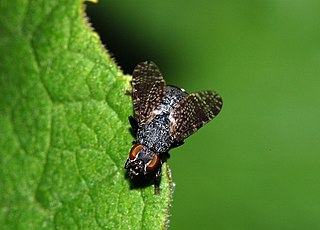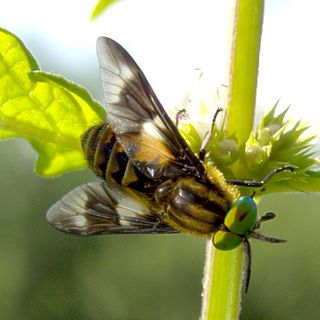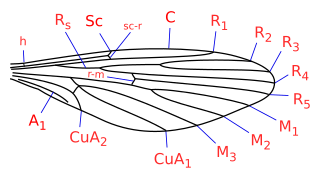
Psychodidae, also called drain flies, sink flies, filter flies, sewer flies, or sewer gnats, is a family of true flies. Some genera have short, hairy bodies and wings, giving them a "furry" moth-like appearance, hence one of their common names, moth flies. Members of the sub-family Phlebotominae, which are hematophagous, may be called sand flies in some countries, although this term is also used for other unrelated flies.
The Nymphomyiidae are a family of tiny (2 mm) slender, delicate flies (Diptera). Larvae are found among aquatic mosses in small, rapid streams in northern regions of the world, including northeastern North America, Japan, the Himalayas, and eastern Russia. Around a dozen extant species are known, with two fossil species found in amber, extending back to the Mid Cretaceous. Under an alternative classification, they are considered the only living representatives of a separate, suborder called Archidiptera which includes several Triassic fossil members. The family has characteristics associated with the Nematocera as well as the Brachycera. The antennae are shortened as in the Brachycera and these flies are long, having a snout with vestigeal mouthparts, non-differentiated abdominal segments with large cerci. The wings are narrow and hair-fringed and have very weak venation. They are known to form cloud-like swarms in summer and the short-lived non-feeding adults have wings that fracture at the base shortly after mating.

The Phlebotominae are a subfamily of the family Psychodidae. In several countries, their common name is sandfly, but that name is also applied to other flies. The Phlebotominae include many genera of blood-feeding (hematophagous) flies, including the primary vectors of leishmaniasis, bartonellosis and pappataci fever.

Clusiidae or "druid flies" is a family of small, thin, yellow to black acalyptrate flies with a characteristic antenna and with the wing usually partially infuscated. They have a cylindrical body. The head is round, the vertical plate reaches the anterior margin of the frons and the vibrissae on the head are large. The costa is interrupted near subcosta and the latter developed throughout length. Larvae are found in the bark of trees, the flies on trunks. The larvae are notable for their ability to jump. Males of many species in the subfamily Clusiodinae have been observed while engaged in lekking behaviour. There are hundreds of species in 14 genera found in all the Ecoregions, although most species occur in tropical regions. The type genus is Clusia Haliday, 1838.

Platypezidae is a family of true flies of the superfamily Platypezoidea. The more than 250 species are found worldwide primarily in woodland habitats. A common name is flat-footed flies, but this is also used for the closely related Opetiidae which were formerly included in the Platypezidae.

The Platystomatidae are a distinctive family of flies (Diptera) in the superfamily Tephritoidea.

Superfamily Tabanoidea are insects in the order Diptera.

The Psychodinae are the nominate subfamily of moth flies (Psychodidae), also known as drain flies. Like most of their relatives, they are usually found in damp habitats; some occur in caves. The small larvae are aquatic or semi-terrestrial; the adults are winged and capable of flight. Psychodinae are found worldwide, including some subantarctic islands.

Chrysotus is a genus of flies in the family Dolichopodidae. It is one of the largest genera in the subfamily Diaphorinae, with more than 460 species. However, the genus is probably paraphyletic, and possibly even polyphyletic, with respect to several related genera such as Achradocera, Falbouria and Lyroneurus.
Elliponeura is a genus of grass flies in the family Chloropidae. There is at least one described species in Elliponeura, E. debilis.
Lagaroceras is a genus of fruit flies in the family Chloropidae. There are about 19 described species in Lagaroceras.
Metopostigma is a genus of frit flies in the family Chloropidae. There are about nine described species in Metopostigma.

Andy Z. Lehrer was a Romanian entomologist. From 1996 until his death, he worked as a research associate in the laboratory of Zoology at the University of Tel Aviv in Tel Aviv, Israel. For several years, he studied flesh flies and blow flies from all over the world.
Boreofairchildia nearctica, the sugarfoot moth-fly, is a species of nematoceran flies in the family Psychodidae. It is endemic to the United States.

Nemopalpus is a genus of moth fly in the family Psychodidae, in the subfamily Bruchomyiinae. Recently (2018) a number of similar species have been transferred to the genera: Alexanderia, Boreofairchildia, Laurenceomyia and Notofairchildia. In Macquart's original publication, the genus name was spelled both as Nemopalpus and Nemapalpus, but Macquart corrected the error in 1839.
Boreofairchildia is a genus of moth flies in the subfamily Bruchomyiinae. Species have been recorded from the Americas, principally Central and South America, with many, including the type, transferred from the genus Nemopalpus.

Notofairchildia is a genus of moth flies in the subfamily Bruchomyiinae. Species have been recorded principally from South America, with many, including the type, transferred from the genus Nemopalpus.
Laurenceomyia is a genus of moth flies in the subfamily Bruchomyiinae. Species have been recorded principally from south America, with many, including the type, transferred from the genus Nemopalpus.
Alexanderia is a genus of moth flies in the subfamily Bruchomyiinae. This genus circumscribes species from south-east Asia, with three including the type, transferred from the genus Nemopalpus.
Bruchomyia is a genus of moth flies in the subfamily Bruchomyiinae. Species have been recorded principally from South America.











